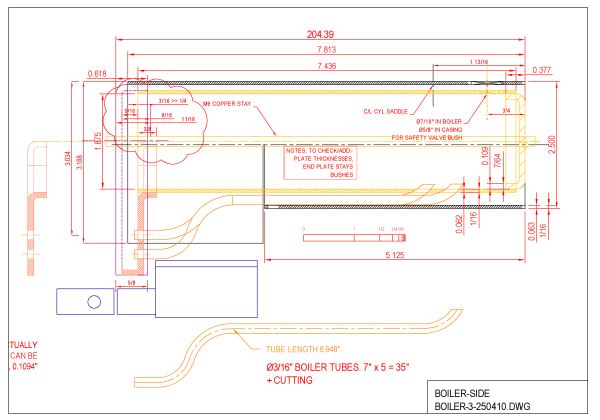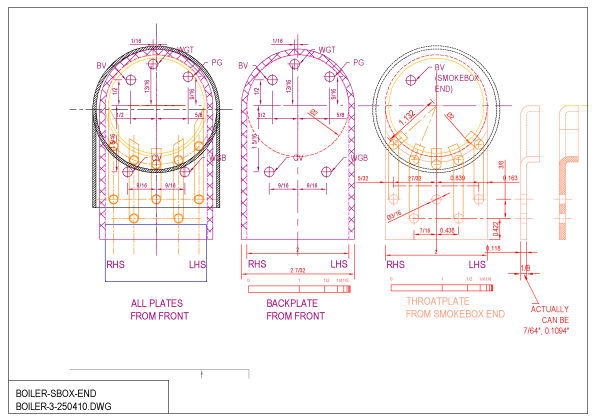Making A Copper Boiler for the 3/4″ Scale Burrell Traction Engine
Part 1 Boiler Details and Design
The design of the boiler for the 3/4″ scale Burrell Traction engine, as shown on the Bassett Lowke drawings from 1950 is a bit unusual – particularly when compared to todays model engineering boiler practice.
For those who know boiler types it’s a cross between a water-tube smithies pot boiler and a locomotive type boiler. It has a wet backhead (called a downcomer on the drawings) and external water tubes underneath and externally-fired pot boiler.
This extract from the original 1950 drawing explains it:-
Notable Features of the Original Bassett Lowke Boiler Design
The Downcomer
The most obvious feature is the wet backhead (called a Downcomer on the Bassett Lowke drawing). Nothing wrong with this in principle but it calls for a gunmetal casting which is commercially unavailable. One would have to either make a casting or have a casting made.
The other option – which I followed is to replace the casting with formed sheet copper. This of course meant a lot of work in re-designing this aspect of the boiler.
The Water Tubes
Again, nothing wrong with the principle here, they will help to provide a good water circulation and add to the heating surface. My issue is from the buildability point of view.
I can see it will be very difficult to install the tubes and undertake the silver soldering. I just can’t see how the pre-formed tubes could be inserted into the boiler shell and downcomer without distorting the tubes. At only 3/16″ diameter they will be very frail and easily distorted after annealing. I know because I have them here.
Working Pressure
I can find no mention of working (and hence test pressure) of the boiler anywhere in the Bassett Lowke drawings and instructions.
I will have to select suitable pressures based upon an analysis of the boiler components in accordance with the Yield Point Method written by myself and Les Smith, Phd.
More on this to follow later.
Just a quick note – it seems to me that the weakest part of this boiler design (from a strength perspective) will be the flat plates forming the downcomer and the front plate. (Called a front tubeplate in loco and traction engine parlance)
So I have added a longitudinal stay supporting those elements which in any case became necessary to locate the flat plates during forming. Explained later.
Boiler Fittings
There are no details of boiler fittings, such as pressure gauge, water gauge, blower valve, safety valve etc,, on the Bassett Lowke drawings. Bassett Lowke, of course, expected builder of this model to purchase those fitting from his company.
As far as it goes, that’s OK, I can source or make all those fittings. The issue for me – as far as building the boiler goes – is that I have to research and design/select those fittings in order to determine what size and thread of bushes to put into the boiler before it is finally silver-soldered up.
Design and CAD Drawings
As explained in the introduction to building the Bassett Lowke 3/4″ scale Burrell Steam Traction Engine I’m developing my own CAD drawings as the build progresses.
Here are some of the CAD drawings I have made to date for the boiler. Please note that by no means are these ‘finished’ drawings.
Part 2 – Building The Boiler
The next post will illustrate the boiler-making process, including flanging the plates, making the formers etc, plus, of course appropriate photos and CAD drawings.
Please Comment Below
As they say on Youtube “Please comment and subscribe”. This helps you to stay informed and helps the search engines to bring these pages before a wider interested audience.


